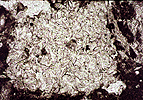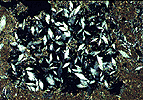


This is the process responsible for accumulating gypsum (CaSO4.2H2O), typical of the more or less arid regions. In soils with high concentrations in salts, gypsum accumulations are often produced due to precipitation as a result of the concentration of the soil solution due to the effect of evaporation and suction of water by the roots of plants.
It forms white accumulations, similar to those
of carbonates, but easily distinguishable in the microscope. Gypsum
crystals have rhombic shapes and grey interference colours.



Secondary accumulation of gypsum crystals in the soil is demonstrated by their localisation in voids.
